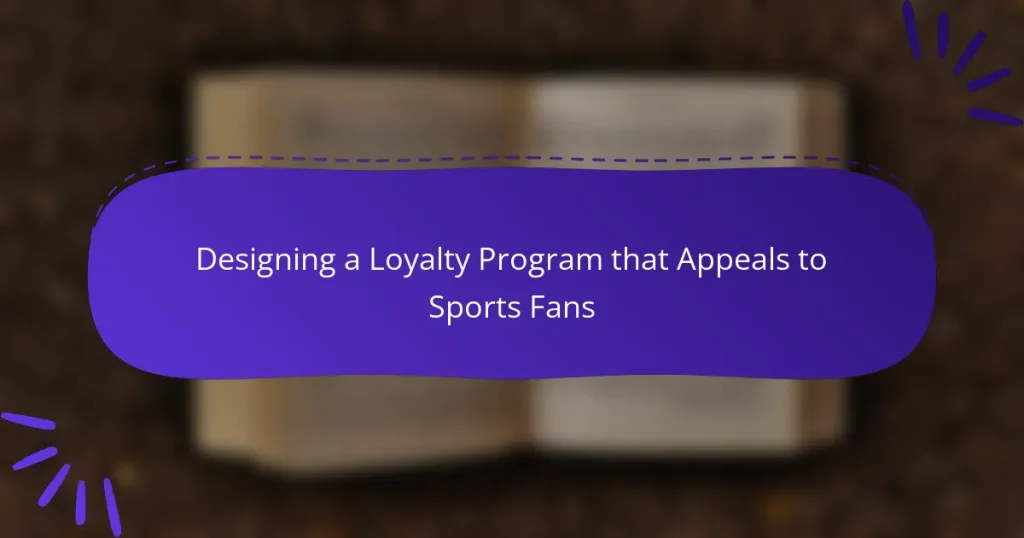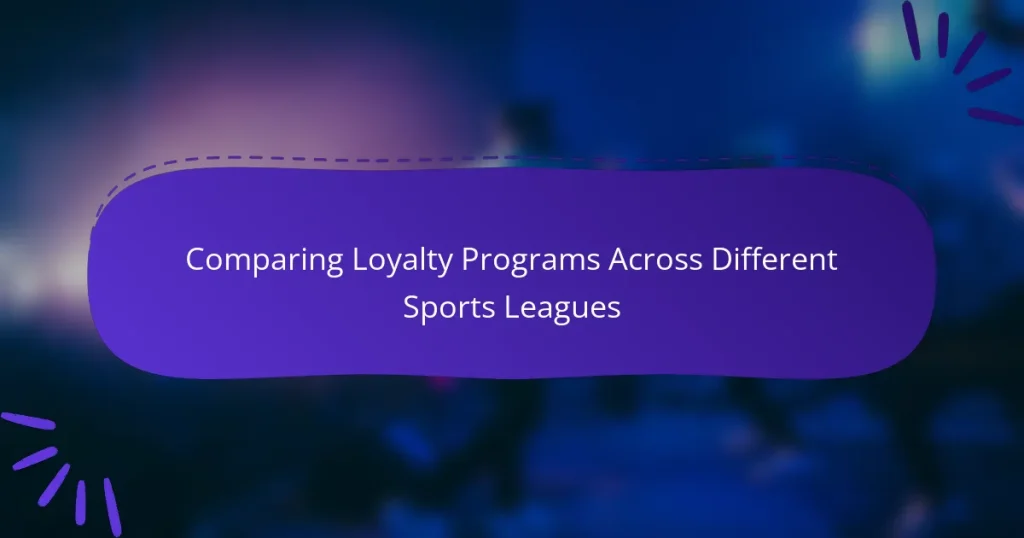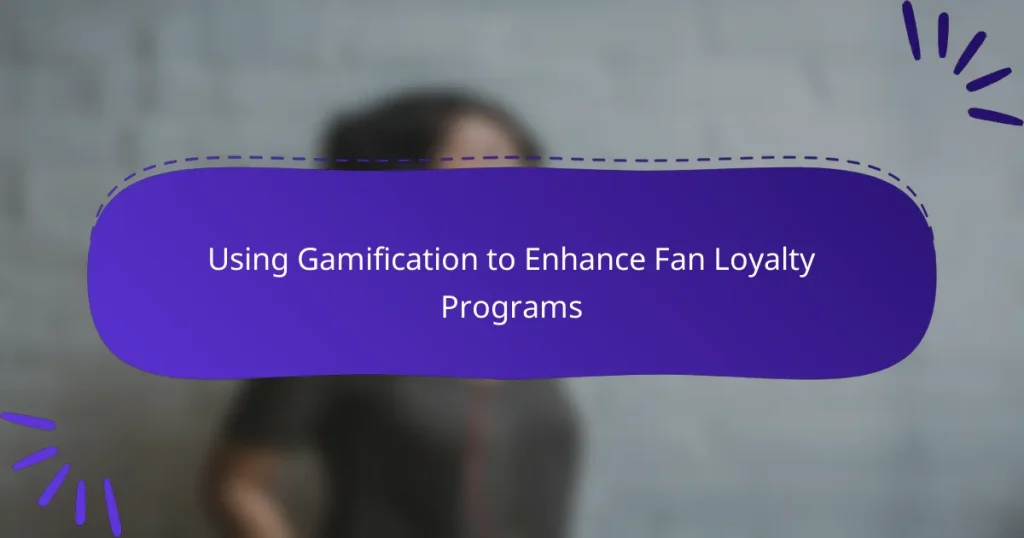Fan loyalty programs are designed to encourage and reward supporters for their ongoing engagement with a brand or team. By allowing fans to earn points through purchases and participation, these programs create opportunities for redeeming rewards that enhance their overall experience and connection. As a result, they not only foster deeper loyalty but also contribute to business growth and customer retention.
Comparing Loyalty Programs Across Different Sports Leagues
Using Gamification to Enhance Fan Loyalty Programs
How do fan loyalty programs work?
Fan loyalty programs incentivize fans to engage with a brand or team by rewarding them for their support and participation. These programs typically involve earning points or rewards through purchases, attendance, and other interactions, which can then be redeemed for various benefits.
Points-based rewards system
A points-based rewards system allows fans to accumulate points for specific actions, such as buying merchandise, attending games, or engaging on social media. For example, fans might earn 1 point for every dollar spent, which can later be redeemed for discounts or exclusive items.
Many programs set thresholds for redeeming points, encouraging fans to reach certain levels before claiming rewards. This can create a sense of achievement and motivate continued engagement.
Tiered membership levels
Tiered membership levels categorize fans based on their engagement and spending, offering different benefits at each level. For instance, a program might have basic, silver, and gold tiers, with gold members receiving the most exclusive perks.
Advancing through tiers often requires meeting specific criteria, such as accumulating a certain number of points or making a minimum number of purchases. This structure fosters a competitive spirit among fans and encourages loyalty.
Exclusive access to events
Exclusive access to events is a significant draw for many fan loyalty programs. Members may receive early ticket access, invitations to private events, or meet-and-greet opportunities with players or celebrities.
These exclusive experiences can enhance the emotional connection fans feel towards a team or brand, making them more likely to remain loyal. It’s essential to communicate these opportunities clearly to maximize engagement.
Personalized offers
Personalized offers tailor rewards and promotions to individual fans based on their preferences and behavior. For example, a fan who frequently attends games might receive discounts on future tickets or merchandise related to their favorite player.
Using data analytics to understand fan behavior can significantly enhance the effectiveness of personalized offers. However, it’s crucial to balance personalization with privacy concerns, ensuring fans feel comfortable with how their data is used.
What are the benefits of fan loyalty programs?
Fan loyalty programs offer numerous advantages that enhance customer relationships and drive business growth. These programs typically reward repeat customers, leading to increased retention, higher spending, and deeper engagement with the brand.
Increased customer retention
Customer retention is a primary benefit of fan loyalty programs, as they encourage repeat purchases by rewarding loyal customers. By offering points, discounts, or exclusive access, businesses create incentives for customers to return rather than seeking alternatives.
For example, a sports team might offer loyalty points for every ticket purchased, which can be redeemed for merchandise or future tickets. This not only keeps fans engaged but also fosters a sense of belonging and community.
Higher average order value
Fan loyalty programs can lead to a higher average order value, as customers are more likely to spend more to earn rewards. When customers know they can accumulate points or unlock benefits, they may be motivated to add extra items to their cart.
For instance, a restaurant might implement a loyalty program where customers earn double points on orders over a certain amount. This strategy encourages customers to increase their spending to maximize rewards, benefiting both the customer and the business.
Enhanced brand engagement
Enhanced brand engagement is another significant benefit of fan loyalty programs, as they create opportunities for meaningful interactions between the brand and its customers. Engaged customers are more likely to share their experiences, recommend the brand, and participate in community events.
For example, a clothing brand might host exclusive events for loyalty members, allowing them to preview new collections or meet designers. Such initiatives strengthen the emotional connection between the brand and its fans, leading to long-term loyalty and advocacy.
Which brands have successful fan loyalty programs?
Brands like Starbucks, Sephora, and Amazon have established successful fan loyalty programs that enhance customer engagement and retention. These programs often reward customers with points, exclusive offers, and personalized experiences, making them valuable tools for building brand loyalty.
Starbucks Rewards
Starbucks Rewards allows customers to earn stars for every purchase, which can be redeemed for free drinks and food items. Members can also enjoy perks like free birthday treats and early access to new products. The program is free to join and can be accessed through the Starbucks app, making it convenient for frequent visitors.
To maximize benefits, customers should consider using the app to order ahead, which can save time and earn additional stars. Regularly checking for bonus star promotions can also enhance rewards accumulation. Avoiding the temptation to redeem stars too quickly can lead to greater rewards over time.
Sephora Beauty Insider
Sephora’s Beauty Insider program offers tiered rewards based on annual spending, allowing members to earn points on purchases that can be exchanged for exclusive products and experiences. The program features three tiers: Insider, VIB, and Rouge, each with increasing benefits such as free shipping and access to special events.
To make the most of the program, customers should sign up for the newsletter to stay informed about special promotions and double points events. Engaging with the community through reviews and social media can also lead to additional rewards. Members should be mindful of their spending to reach higher tiers for better rewards.
Amazon Prime
Amazon Prime is a subscription-based loyalty program that offers a variety of benefits, including free two-day shipping, access to streaming services, and exclusive discounts. The annual fee for Prime membership can vary, but it typically offers substantial savings for frequent Amazon shoppers.
To maximize the value of Amazon Prime, members should utilize the free shipping benefit for regular purchases and explore the streaming content available. Taking advantage of Prime Day and other exclusive sales can also yield significant savings. However, customers should evaluate whether the subscription cost aligns with their shopping habits to ensure it remains beneficial.
How can businesses implement fan loyalty programs?
Businesses can implement fan loyalty programs by establishing clear objectives, selecting suitable technology platforms, and designing effective reward structures. These steps ensure that the program meets both the needs of the fans and the goals of the business.
Define program goals
Defining program goals is crucial for the success of a fan loyalty program. Businesses should identify what they want to achieve, such as increasing repeat purchases, enhancing customer engagement, or boosting brand awareness. Clear goals help in measuring the program’s effectiveness and adjusting strategies as needed.
For example, a sports team may aim to increase attendance at games by offering rewards for ticket purchases, while a retail brand might focus on driving online sales through exclusive discounts for loyal customers. Setting specific, measurable goals can guide the program’s design and implementation.
Select a technology platform
Choosing the right technology platform is essential for managing fan loyalty programs effectively. Businesses should consider platforms that offer user-friendly interfaces, integration capabilities with existing systems, and robust analytics tools. Popular options include customer relationship management (CRM) systems and dedicated loyalty program software.
For instance, a mobile app can facilitate easy access to rewards and promotions, while a web-based platform can provide detailed insights into customer behavior. It’s important to select a platform that aligns with the business’s size and budget, ensuring scalability as the program grows.
Design reward structures
Designing effective reward structures is key to motivating fans and encouraging participation in loyalty programs. Businesses should consider various types of rewards, such as discounts, exclusive merchandise, or experiences like meet-and-greets. A tiered system can also be beneficial, where fans earn more significant rewards as they engage more with the brand.
For example, a coffee shop might offer a free drink after every ten purchases, while a concert venue could provide VIP access to loyal attendees. It’s crucial to ensure that the rewards are desirable and attainable, as this will enhance customer satisfaction and foster long-term loyalty.
What are the challenges of fan loyalty programs?
Fan loyalty programs face several challenges that can impact their effectiveness and sustainability. Key issues include maintaining customer interest, addressing data privacy concerns, and integrating with existing systems.
Maintaining customer interest
Keeping fans engaged in loyalty programs is crucial for their success. Programs must continually offer appealing rewards and experiences to prevent participants from losing interest. Regularly updating incentives and introducing exclusive events can help maintain excitement.
For example, sports teams might offer unique merchandise, special meet-and-greet opportunities, or exclusive access to games. These offerings should evolve based on fan feedback and trends to ensure ongoing engagement.
Data privacy concerns
Data privacy is a significant concern for fans participating in loyalty programs. Organizations must ensure that personal information is handled securely and transparently to build trust. Compliance with regulations such as GDPR in Europe or CCPA in California is essential to avoid legal issues.
To address these concerns, companies should implement clear privacy policies and provide fans with options to control their data. Regular audits and updates to security measures can further enhance trust and participation.
Integration with existing systems
Integrating loyalty programs with existing systems can be a complex challenge. Organizations must ensure that their loyalty platforms work seamlessly with customer relationship management (CRM) systems, payment processors, and marketing tools. This integration is vital for tracking customer interactions and delivering personalized experiences.
To facilitate integration, businesses should invest in flexible technology solutions that can adapt to their current infrastructure. Conducting thorough testing before launching new features can help identify potential issues and streamline the user experience.
What metrics should be tracked for fan loyalty programs?
To effectively manage fan loyalty programs, it is essential to track metrics that reflect customer engagement and program effectiveness. Key metrics include customer lifetime value and redemption rates, which provide insights into the program’s impact on fan retention and spending behavior.
Customer lifetime value
Customer lifetime value (CLV) measures the total revenue a business can expect from a single customer throughout their relationship. For fan loyalty programs, understanding CLV helps identify the long-term value of loyal fans versus casual attendees.
To calculate CLV, consider factors such as average purchase value, purchase frequency, and customer lifespan. For example, if a fan spends an average of $50 per game, attends 10 games a year, and remains a fan for 5 years, their CLV would be $2,500. This metric can guide investment in marketing and rewards.
Redemption rates
Redemption rates indicate how often fans utilize rewards or benefits from loyalty programs. A high redemption rate suggests that fans find the rewards appealing and attainable, while a low rate may indicate that rewards are not enticing or accessible enough.
To improve redemption rates, regularly assess the types of rewards offered and ensure they align with fan preferences. For instance, offering exclusive merchandise or experiences can drive engagement. Tracking redemption rates over time can help identify trends and adjust strategies accordingly.


